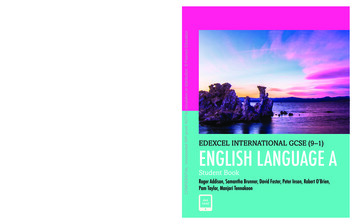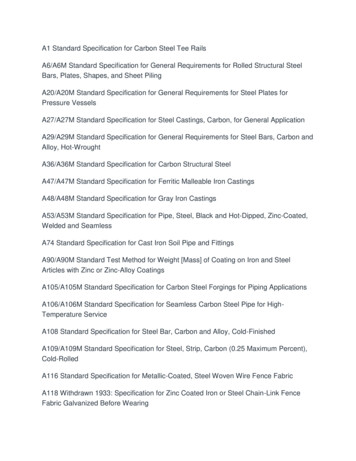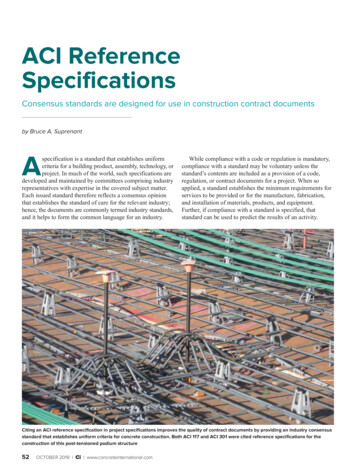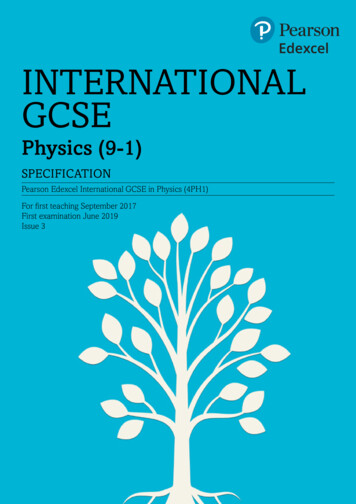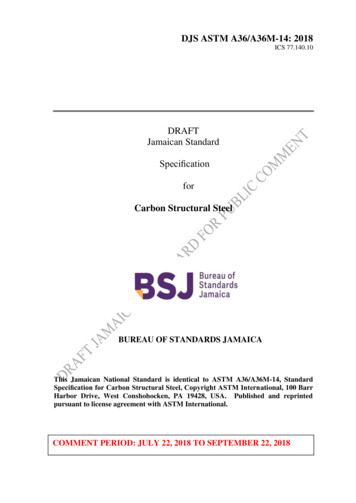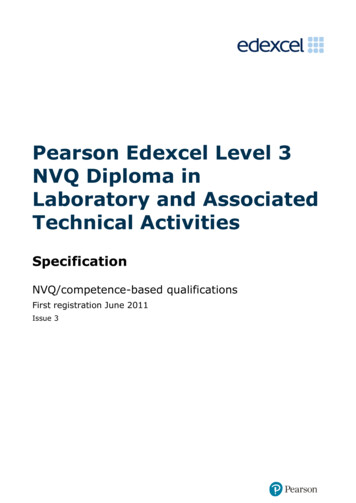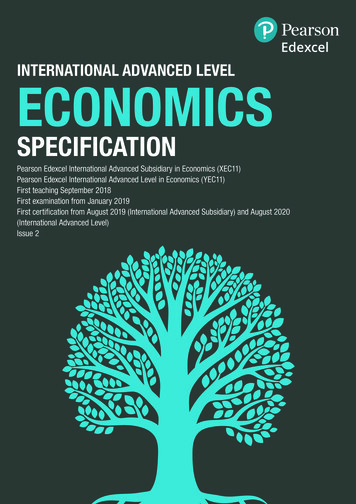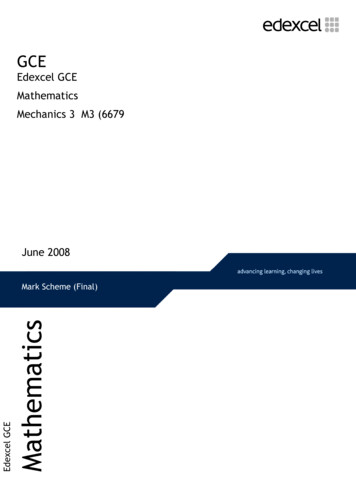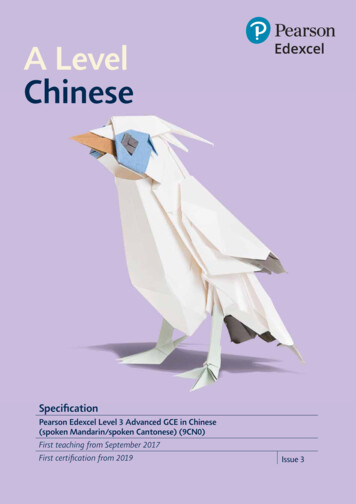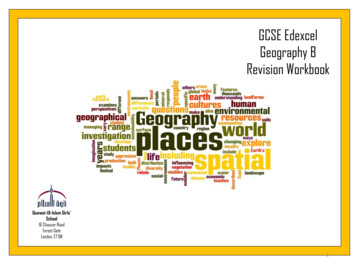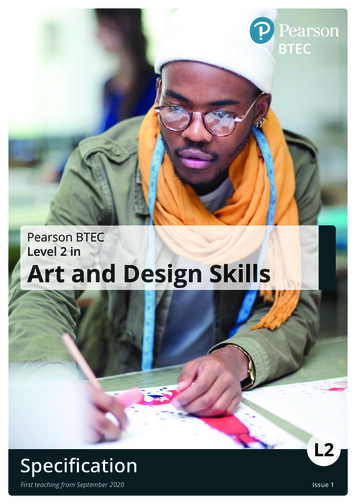
Transcription
Pearson BTECLevel 2 inArt and Design SkillsSpecificationFirst teaching from September 2020L2Issue 1
Edexcel, BTEC and LCCI qualificationsEdexcel, BTEC and LCCI qualifications are awarded by Pearson, the UK’s largest awarding bodyoffering academic and vocational qualifications that are globally recognised and benchmarked.For further information, please visit our qualifications website at qualifications.pearson.com. Alternatively, you can get in touch with us using the details on our contact us page atqualifications.pearson.com/contactusAbout PearsonPearson is the world’s leading learning company, with 35,000 employees in more than 70 countriesworking to help people of all ages to make measurable progress in their lives through learning.We put the learner at the centre of everything we do, because wherever learning flourishes, so dopeople. Find out more about how we can help you and your learners at tock.com: Yuliya Loginova, Chaosamran Studio, VL1, Iryna Inshyna, RossHelen, SydaProductions, Kuznetcov Konstantin, marigo20, Chaosamran Studio, JJFarq, Diego Cervo, DragonImages, Air Images, MikeDotta, PR Image Factory, MarmolejosReferences to third-party material made in this specification are made in good faith. We do notendorse, approve or accept responsibility for the content of materials, which may be subject to change,or any opinions expressed therein. (Material may include textbooks, journals, magazines and otherpublications and websites.)ISBN 978 1446 96631 0All the material in this publication is copyright Pearson Education Limited 2020
CONTENTS1 Qualification Purpose2 Structure410Assessment12Total Qualification Time13Grading In These Qualifications14Qualification Design15Understanding Your Learning And Teaching Modules And Assessment Units173 Learning And Teaching Modules18Module A:exploring And Developing Art And Design Skills19Module B:personal Development31Module C:responding To A Creative Brief374 Planning Your Programme465 Assessment Structure50Assessment Units51Making Valid Assessment Decisions516 Administrative Arrangements54Learner Registration And Entry55Access To Assessment56Administrative Arrangements For Assessment57Dealing With Malpractice58Additional Documents To Support Centre Administration597 Quality Assurance608 Understanding The Qualification Grade649 Resources And Support80Support For Setting Up Your Course And Preparing To Teach81Support For Assessment83Training And Support From Pearson84Appendix 1: G lossary Of Terms Used For Internally-Assessed Learning AndTeaching Modules86Appendix 2: LARGE FORMAT ASSESSMENT CRITERIA GRID89
INTRODUCTION TO BTEC LEVEL 2QUALIFICATIONS IN ART AND DESIGN SKILLSWelcome to your new specification for thePearson BTEC Level 2 in Art and Design Skillsqualifications. These qualifications bring youthe best of the BTEC tradition of developingindependent, vocationally aware learnersthrough the right balance between teaching/learning and assessment. The qualificationshave been designed around holistic,explorative and integrated creative teachingapproaches that are conducive to deeplearning and skills development.These qualifications support a curriculumwhere learners continually revisit their skills,adding levels of refinement, sophistication andprecision as they progress.Pearson BTEC Level 2 in Art and Design Skills –Specification – Issue 1 - August 2020 Pearson Education Limited 20201
KEY FEATURES 100% internally set and assessed – allassessments are set and assessed by youand verified by Pearson. We provide asupport visit to help you to make sure thatyou are confident in delivering all aspectsof teaching, assessment and verification. 100% internally set and assessed – allassessments are set and assessed by youand verified by Pearson. Multidisciplinary practice – there are nospecialist pathways in these qualifications.This is in order to enable and encouragemultidisciplinary practice and integrationof the relevant skills that learners wantto develop. Practical skills have beenexpressed through the following categoriesto allow for development and integration ofskills across practices, including skills usedacross art, design and media (teachersdelivering pathway-specific programmescan select the technical skills relevant totheir specialism in or across any of thesecategories): Compensation in grading – grading iscompensatory in assessment units andacross qualifications, rewarding learnersfor their exceptional performance in someareas, without requiring it in all areas. Formore information on grading see Section 7:Understanding the qualification grade. Highly practical – all assessment is holistic,based on portfolios of work. Evidence isgenerated through practical projects, briefsand workshops. Common assessment criteria – the samefive common assessment criteria are usedto assess all work produced throughoutthe qualification. This simplifies assessmentand means that it is clear what learners areexpected to do to achieve the criteria. Content areas match assessment criteria– content for each unit is divided intofive areas, which link directly to theassessment criteria. image and mark fashion, wearable and textiles 3D, space and product moving image and lens graphic and digital communication. Simple structure – four assessmentunits across the specification, two in theCertificate, three in the Extended Certificateand all four in the Diploma. Grades weighted to reflect development –in the Diploma the grade will be weightedtowards the final assessment to ensurethat achievement reflects the stage whenlearners have had maximum opportunityto develop their skills and to apply theirfull potential.2Pearson BTEC Level 2 in Art and Design Skills –Specification – Issue 1 - August 2020 Pearson Education Limited 2020
MANDATORY CONTENTTo deepen and refine their skills over time,learners need access to teaching and learningapproaches that challenge them. This issupported by five mandatory content areasthat reflect the fundamental creative skillsrunning through all teaching and learning,and which are developed to give learnersvaluable transferable skills. These five contentareas are: investigation communication practical skills development approach.Within the scope of the areas of content, thespecific skills and practices listed in each areashould be taught as they apply to learners’interests, ideas and career or progressionambitions across art and design.The five key areas of content allow for thesimple and consistent presentation ofrequirements. This recognises the need forintegration of skills for any art and designproject, ensuring that teachers can identifythe most relevant methods of delivery toengage each learner.ASSESSMENT UNITSEach assessment unit is highly practical andbased on assignments set internally by theteacher. The number of assessment unitswithin each qualification are:You will assess learners using a single setof criteria that covers all assessment units.Grades awarded for each criterion correspondto a point value and points accumulate toestablish the overall qualification grade.QUALITY ASSURANCEQuality assurance processes follow welldefined BTEC approaches designed tosupport you simply and effectively. We haverefined our approach to supporting theseunique creative qualifications to take accountof the simplified teaching and assessmentstructure. For more information see Section 6:Quality assurance.QUALIFICATIONS IN THESECTORThe qualifications included in thisspecification are: Pearson BTEC Level 2 Certificate in Art andDesign Skills (180 GLH) (603/5543/8) Pearson BTEC Level 2 Extended Certificatein Art and Design Skills (240 GLH)(603/5544/X) Pearson BTEC Level 2 Diploma in Art andDesign Skills (360 GLH) (603/5547/5).These qualifications have been designed tomeet learner needs flexibly and they do notinclude external assessment. Therefore, theyare not recognised on performance tables Pearson BTEC Level 2 Certificate in Art andDesign Skills – two assessment units Pearson BTEC Level 2 ExtendedCertificate in Art and Design Skills – threeassessment units Pearson BTEC Level 2 Diploma in Art andDesign Skills – four assessment units.Pearson BTEC Level 2 in Art and Design Skills –Specification – Issue 1 - August 2020 Pearson Education Limited 20203
1QUALIFICATIONPURPOSE
In this section, you will find information on the purposes of the:Pearson BTEC Level 2 Certificate in Art and Design SkillsPearson BTEC Level 2 Extended Certificate in Art and Design SkillsPearson BTEC Level 2 Diploma in Art and Design Skills.We publish a full ‘Statement of Purpose’for each qualification on our website.These statements are designed to guideyou and potential learners to make themost appropriate choice as to the size ofqualification that is suitable at recruitment.These qualifications have been designedto provide post-16 learners with the skills,knowledge and understanding necessaryto progress to further education ortraining in related subject areas or to gainfundamental creative skills that are valued inother subject areas. As such, underpinningskills for progression within creative sectoreducation, and for working productively withinany educational or working environment,have been embedded throughout eachqualification. These skills include creativeinvestigation and ideas generation,communication, using creative developmentprocesses, developing and applying practicalskills and using productive working skillsand practice.The structures of these qualifications havebeen designed to allow time for skillsdevelopment and large-scale projects tobe carried out. The number and natureof assessments within each qualificationhave been devised to be undertaken at keypoints in learners’ progression through theprogramme, reflecting the culmination of skillsdevelopment and ability. This allows teachersto provide a holistic learning experience thatbalances development of skills with personalgrowth and intentions. The breadth of study ineach qualification gives learners opportunitiesto consider their practice in the context ofvocational practice, with work from inceptionof ideas to completion.Inclusivity is a key objective of thesequalifications. Assessments do not prescribethe types of evidence required, allowingeach learner to access the full range ofachievement using the methods of workingbest suited to them. Core technical skillsdevelopment that covers all specialisms hasbeen combined into shared mandatory units.This means that all learners will demonstratethe level of their skills through the sameunits, regardless of individual accessibilityneeds, which enhances inclusivity and parityof assessment.Pearson BTEC Level 2 in Art and Design Skills –Specification – Issue 1 - August 2020 Pearson Education Limited 20205
PEARSON BTEC LEVEL 2 CERTIFICATE IN ARTAND DESIGN SKILLSThe 180-GLH Certificate, equivalent to 1.5 GCSEs, is for learners who are looking to study artand design as part of a one-year course alongside other areas of study. If taken as part of aprogramme of study that includes other BTECs or GCSEs, it supports progression to Level 3 studyin art and design or can provide fundamental creative skills that are valued in other subject areassuch as creative media, engineering, business or marketing. It could also support progression toan apprenticeship in art and design or a related sector.WHAT DOES THISQUALIFICATION COVER?WHAT COULD THISQUALIFICATION LEAD TO?The content of this qualification has beendeveloped in consultation with teachersand industry professionals to ensure thatit supports progression to further study ortraining at Level 3. These consultants haveensured that the content is appropriate forstudy at Level 2, and consistent with currentindustry practice, providing learners with afoundation in the skills needed to progressto further education with an understandingof industry and the roles and opportunitiesavailable to them.Learners who complete this qualificationalongside other Level 2 qualifications mayprogress to further learning at Level 3, forexample the Pearson BTEC National ExtendedDiploma in Art and Design Practice or a 540GLH Diploma in Art and Design alongsideanother diploma in a complementary sector.Learners taking this qualification will study onemandatory learning and teaching module: Exploring and Developing Art andDesign Skills.6This qualification gives learners theopportunity to develop their technical artand design skills through a process of selfevaluation, practice and review. In additionto the sector-specific content available inthis qualification, the requirements meanthat learners develop the transferable skillsneeded to progress to further education andultimately higher education and employment,for example communication, planning andmanaging projects and creative problemsolving. The qualification also supportslearners in becoming more confident in takingownership of and responsibility for their owndirection, work and choices.Pearson BTEC Level 2 in Art and Design Skills –Specification – Issue 1 - August 2020 Pearson Education Limited 2020
PEARSON BTEC LEVEL 2 EXTENDEDCERTIFICATE IN ART AND DESIGN SKILLSThe 240-GLH Extended Certificate, equivalent to two GCSEs, is for learners who are looking tostudy art and design as part of a one-year course alongside other areas of study. If taken aspart of a programme of study that includes other BTECs or GCSEs, it supports progression toLevel 3 study in art and design or can provide fundamental creative skills that are valued in othersubject areas such as creative media, engineering, business or marketing. It could also supportprogression to an apprenticeship in art and design or a related sector.WHAT DOES THISQUALIFICATION COVER?WHAT COULD THISQUALIFICATION LEAD TO?The content of this qualification has beendeveloped in consultation with teachersand industry professionals to ensure thatit supports progression to further study ortraining at Level 3. These consultants haveensured that the content is appropriate forstudy at Level 2, and consistent with currentindustry practice, providing learners with afoundation in the skills needed to progressto further education with an understandingof industry and the roles and opportunitiesavailable to them.Learners who complete this qualificationalongside other Level 2 qualifications mayprogress to further learning at Level 3, forexample the Pearson BTEC National ExtendedDiploma in Art and Design Practice or a 540GLH Diploma in Art and Design alongsideanother diploma in a complementary sector. Learners taking this qualification willstudy two mandatory learning andteaching modules: Exploring and Developing Art andDesign Skills Personal Development.This qualification gives learners theopportunity to develop their technical artand design skills through a process of selfevaluation, practice and review. In additionto the sector-specific content available inthis qualification, the requirements meanthat learners develop the transferable skillsneeded to progress to further education andultimately higher education and employment,for example communication, planning andmanaging projects and creative problemsolving.The qualification also supports learners inbecoming more confident in taking ownershipof and responsibility for their own direction,work and choices.Pearson BTEC Level 2 in Art and Design Skills –Specification – Issue 1 - August 2020 Pearson Education Limited 20207
PEARSON BTEC LEVEL 2 DIPLOMA IN ART ANDDESIGN SKILLSThe 360-GLH Diploma, equivalent to three GCSEs, is for learners who are looking to study artand design as a one-year, full-time course and for those who wish to take it alongside anothercomplementary area study as part of a one-year, full-time study programme. If taken as part of aprogramme of study that includes other BTECs or GCSEs, it supports progression to Level 3 studyin art and design. It can also provide fundamental creative skills that are valued in other subjectareas such as creative media, engineering, business or marketing, or support progression to anapprenticeship in art and design or a related sector.WHAT DOES THISQUALIFICATION COVER?WHAT COULD THISQUALIFICATION LEAD TO?The content of this qualification has beendeveloped in consultation with teachersand industry professionals to ensure thatit supports progression to further study ortraining at Level 3. These consultants haveensured that the content is appropriate forstudy at Level 2, and consistent with currentindustry practice, providing learners with afoundation in the skills needed to progressto further education with an understandingof industry and the roles and opportunitiesavailable to them.Learners who complete this qualification mayprogress to further learning at Level 3, forexample the Pearson BTEC National ExtendedDiploma in Art and Design Practice or a 540GLH Diploma in Art and Design alongsideanother diploma in a complementary sector.Learners taking this qualification willstudy three mandatory learning andteaching modules: Exploring and Developing Art andDesign Skills Personal Development Responding to a Creative Brief.8This qualification gives learners theopportunity to develop their technical artand design skills through a process of selfevaluation, practice and review. In additionto the sector-specific content available inthis qualification, the requirements meanthat learners develop the transferable skillsneeded to progress to further education andultimately higher education and employment,for example communication, planning andmanaging projects and creative problemsolving. The qualification also supportslearners in becoming more confident in takingownership of and responsibility for their owndirection, work and choices.Pearson BTEC Level 2 in Art and Design Skills –Specification – Issue 1 - August 2020 Pearson Education Limited 2020
HOW DO THESEQUALIFICATIONS PROVIDETRANSFERABLE KNOWLEDGEAND SKILLS FOR FURTHERSTUDY?All BTEC qualifications provide transferableknowledge and skills that prepare learners forprogression to further study. The transferableskills that enable learners to progress include: the ability to learn independently the ability to actively investigate andproblem solve practical and personalcommunication skills.BTEC learners can also benefit fromopportunities for deep learning, where theyare able to make connections betweenlearning and teaching modules andassessment units and select areas of interestfor detailed study. BTEC qualifications providea vocational context in which learners candevelop the knowledge and skills required forfurther study at Level 3, such as: teamwork project work presentation skills analytical skills creative development developing and monitoring progresstowards personal aims.Pearson BTEC Level 2 in Art and Design Skills –Specification – Issue 1 - August 2020 Pearson Education Limited 20209
2STRUCTURE
STRUCTURE OF THE QUALIFICATIONSPearson BTEC Level 2 Certificate in Art and Design Skills - Learners must complete twoassessment units and achieve a Pass grade for each assessment criterion.Pearson BTEC Level 2 Extended Certificate in Art and Design Skills - Learners mustcomplete three assessment units and achieve a Pass grade for each assessment criterion.Pearson BTEC Level 2 Diploma in Art and Design Skills - Learners must complete fourassessment units and achieve a Pass grade for each assessment criterion.This table shows all the learning and teaching modules, related assessment units and thequalifications to which they contribute.QualificationLearning and Teaching ModulesRelated Assessment Units180 CertificateAE xploring and Developing Art and Design Skills A1 Skills Development (120 GLH)A2 Art and Design Project (60 GLH)240 ExtendedCertificateAE xploring and Developing Art and Design Skills A1 Skills Development (120 GLH)A2 Art and Design Project (60 GLH)B Personal Development360 DiplomaB1 Personal Development (60 GLH)AE xploring and Developing Art and Design Skills A1 Skills Development (120 GLH)A2 Art and Design Project (60 GLH)B Personal DevelopmentB1 Personal Development (60 GLH)C Responding to a Creative BriefC1 Responding to a Creative Brief(120 GLH)Pearson BTEC Level 2 in Art and Design Skills –Specification – Issue 1 - August 2020 Pearson Education Limited 202011
ASSESSMENTSYNOPTIC ASSESSMENTLANGUAGE OF ASSESSMENTSynoptic assessment requires learners toapply learning from across the qualificationto the completion of defined vocationaltasks. These qualifications have beendesigned to promote iterative and integratedassessment through learning and teachingmodules, providing a strong basis forsynoptic assessment.Assessment of the units for thesequalifications will be available in English.All learner work must be in English. Alearner taking the qualifications may beassessed in British or Irish Sign Languagewhere it is permitted for the purpose ofreasonable adjustment.The synoptic assessment in the Certificateand the Extended Certificate is related toAssessment Unit A2: Art and Design Project.In this assessment unit, learners apply theirlearning synoptically to complete a projectin response to a vocationally relevant brief.The unit assesses learners’ ability to usetheir skills in an integrated way to producea response that meets the requirements ofa brief, applying a range of skills covering allassessment criteria.For information on reasonable adjustmentssee Section 5: Administrative arrangements.In the Diploma, learners build on all threeprior assessment units by responding to acreative brief in the final Assessment UnitC1: Responding to a Creative Brief. This drawson the range of skills developed throughoutthe qualification, assessing learners’ ability tointerpret and respond to a creative vocationalbrief covering all assessment criteria.The assessments will benefit learners whowant to progress to Level 3 qualifications asthey assess learner skills in areas requiredin further education, such as organisationalskills, creative thinking, problem solving andproductive working skills.12Pearson BTEC Level 2 in Art and Design Skills –Specification – Issue 1 - August 2020 Pearson Education Limited 2020
TOTAL QUALIFICATION TIMEFor all regulated qualifications, Pearsonspecifies a total number of hours that it isestimated learners will require to completeand show achievement for the qualification:this is the Total Qualification Time (TQT).Within TQT, Pearson identifies the number ofGuided Learning Hours (GLH) that we estimatea centre delivering the qualification mightprovide. Guided learning means activities,such as lessons, tutorials, online instruction,supervised study and giving feedback onperformance, that directly involve teachersand assessors in teaching, supervising andinvigilating learners. Guided learning includesthe time required for learners to completeassessment under supervised conditions.In addition to guided learning, other requiredlearning directed by teachers or assessorswill include private study, preparation forassessment and undertaking assessmentwhen not under supervision, such aspreparatory research, study and practice,exploration and independent work.BTEC qualifications have been designedaround the number of guided learning hoursexpected. Each assessment unit has a givenGLH value. There is then a total GLH value foreach qualification.The qualifications in this specification have thefollowing TQT values: Pearson BTEC Level 2 Certificate in Art andDesign Skills – 225 TQT Pearson BTEC Level 2 Extended Certificatein Art and Design Skills – 300 TQT Pearson BTEC Level 2 Diploma in Art andDesign Skills - 450 TQT.Pearson BTEC Level 2 in Art and Design Skills –Specification – Issue 1 - August 2020 Pearson Education Limited 202013
GRADING IN THESE QUALIFICATIONS The Pearson BTEC Level 2 Certificate in Artand Design Skills is graded P to D. The Pearson BTEC Level 2 ExtendedCertificate in Art and Design Skills is gradedPP to DD. The Pearson BTEC Level 2 Diploma in Artand Design Skills is graded PP to DD.Each learning and teaching module definesthe range of content that learners will cover.The assessment evidence produced ispresented and assessed against assessmentunits. Assessment units are each assessedagainst five criteria, which are gradedon a scale of Distinction, Merit, Pass andUnclassified. In order to be awarded aqualification, learners must achieve aminimum of Pass in all assessment criteriain each assessment unit. See Section 7:Understanding the qualification grade,for more information on grading and theproportionate weighting of assessment unitstowards overall qualification grades.14Pearson BTEC Level 2 in Art and Design Skills –Specification – Issue 1 - August 2020 Pearson Education Limited 2020
QUALIFICATION DESIGNHow the assessment units work5 assessmentobjectives5 areas of indicativeteaching content5 assessmentcriteriaTo simplify the qualification, all teaching and learning content and assessment have beendesigned around five fundamental skills areas. Each module has a straightforward structure thatclearly connects the assessment objectives, teaching content and assessment criteria: Five assessment objectives Five areas of teaching content Five assessment criteria:1. Investigation2. Communication3. Practical Skills4. Development5. ApproachTHE 5 EQUAL ASSESSMENT CRITERIAThe assessment criteria are not a series of tasks that are done separately. Learners, and creativepractitioners, will use these five skills areas in combination when developing their work. As such,the criteria are all equally weighted, meaning they should be given equal importance in a learners’development and in assessment.AC5: ApproachEngagement in productiveways of working, bothindependently andwith others.AC4: DevelopmentUse of creativedevelopment processesto review and refine workand personal nPracticalskillsAC3: Practical SkillsSelection and manipulation of media, materials,techniques and processes to produce and present workPearson BTEC Level 2 in Art and Design Skills –Specification – Issue 1 - August 2020 Pearson Education Limited 2020AC1: InvestigationResearch, explorationand experimentation toinform understandingof practice anddevelopment ofideas and work as itprogressesAC2: CommunicationCommunicatingideas, intentions anddevelopment throughpractical work andpresentation methods15
GUIDE TO THE MODULES AND HOW THEASSESSMENT OBJECTIVES RELATE DIRECTLYTO CONTENT AND ASSESSMENT CRITERIA:Assessment objectives for Assessment Units A1 and A2A1.1 Explore investigation skills for art and designA1.2 Explore communication skills for art and designA1.3 Explore practical art and design skillsA1.4 Explore development processes for art and designA1.5 Explore productive approaches to working in art and designA2.1 Carry out investigation for an art and design projectA2.2 Use communication skills for an art and design projectA2.3 Use practical skills for an art and design project1. A ssessment objectives arestatements indicating the scopeof learning for the assessmentunit and relate directly to theassessment criteria.A2.4 Carry out development of an art and design projectA2.5 Use productive approaches to working for an art and design projectPRACTICAL SKILLS (AO A1.3 AND A2.3)All practical skills content in this section is indicative and not exhaustive or exclusive.Learners will explore and develop practical skills in using a range of media/materials,techniques and processes relevant to work. Learners may use and integrate anycontent in and/or across the areas of practical skills below; there is no requirement toaddress all the content in any given area of practical skill.Image and markLearners will explore the technical skills related to areas such as graphics, printmaking,illustration, painting, drawing, concept art, digital art, e.g.: Drawing, e.g. sketching, tracing, perspective, technical, diagram.2. T eaching contentis divided intokey areas, whichcorrespond to theassessment objectives. Painting and mixed media, e.g. mixing, transparency, opacity, wet on wet, sgraffito,digital, resist, encaustic, fresco, wash, drybrush, underpainting, glazing, blocking in,building up, impasto, lifting, collage. Printmaking, e.g. mono, lino, collagraph, screen, block, drypoint. Application, e.g. gestural, muscle memory/coordination, scribbling, dripping, pouring,scraping, scratching, pulling, throwing, cutting, ripping, stitching.BTEC Level 3 540 Diploma and Extended Diploma in Art and Practice assessment criteriaIn order to be awarded a qualification, learners must achieve a minimum of Pass in all criteria for each assessment unit. See Appendix 2 for larger municationAC3:Practical ient/tentativePassBasic/generally/partialLimited investigation, research,exploration and experimentationthat tentatively informsunderstanding, ideas, and practice.Basic investigation, using generallyrelevant research, explorationand experimentation during somestages of development to partiallyinform understanding, ideasand practice.Lack of clarity in communicationof intentions, developmentand ideas. Arbitrary use ofpresentation methods andconventions in relation toaudience and type of work.MeritCompetent/clear mostCompetent investigation,clearly using relevantresearch, exploration andexperimentation during moststages of development toinform understanding, ideas,and practice.Basic communication ofCompetent communication ofintentions, development andintentions, development andideas. Presentation methods and ideas. Presentation methods andconventions used are generallyconventions used are appropriateappropriate in relation to audience in relation to audience and natureand nature of work.of work.DistinctionAssured/thorough/sustainedThorough investigation, usingrelevan
Pearson BTEC Level 2 Certificate in Art and Design Skills Pearson BTEC Level 2 Extended Certificate in Art and Design Skills Pearson BTEC Level 2 Diploma in Art and Design Skills. We publish a full 'Statement of Purpose' for each qualification on our website. These statements are designed to guide you and potential learners to make the

